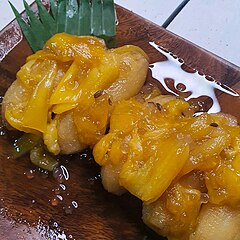  Top: Minatamis na saging with jackfruit Bottom: Saba con yelo | |
| Region or state | Philippines |
|---|---|
| Main ingredients | saba banana, syrup |
| Variations | Saba con yelo |
Minatamis na saging (literally "sweetened banana")[1] is a Filipino dessert made with chopped saba bananas[2] cooked in a sweet syrup (arnibal) made with muscovado sugar and water. Some recipes also add a little bit of salt and pandan leaf or vanilla extract. Other ingredients can also be added like sweet potato, sago,[3] or other fruits like jackfruit. It can be eaten on its own or added as an ingredient to other desserts (notably for halo-halo). Adding the dessert over milk and shaved ice also results in another dessert known as saba con yelo (also sabá con hielo in Spanish).[4][5][6][7]
The dish can also be cooked with coconut milk instead of water, which is differentiated as ginataang saba.[8]
See also[edit]
References[edit]
- ^ Filipinas Magazine. Filipinas Pub. 1995. p. 58. Retrieved July 20, 2021.
- ^ Philpott, Don (October 20, 2016). The World of Wine and Food: A Guide to Varieties, Tastes, History, and Pairings. Rowman & Littlefield. ISBN 978-1-4422-6804-3. Retrieved July 20, 2021.
- ^ Polistico, Edgie (November 15, 2017). Philippine Food, Cooking, & Dining Dictionary. Anvil Publishing, Inc. ISBN 978-621-420-087-0. Retrieved July 20, 2021.
- ^ "Minatamis na Saging (Sweetened Saba Bananas)". Astig Vegan. July 24, 2016. Retrieved March 20, 2019.
- ^ "Minatamis na Saging". Panlasang Pinoy. Retrieved March 20, 2019.
- ^ "Minatamis na Saging Recipe (Caramelized Plantains Dessert)". Mama's Guide Recipes. February 12, 2018. Retrieved April 23, 2019.
- ^ "Minatamis na Kamote, Saging at Sago". Mama's Guide Recipes. November 6, 2017. Retrieved April 23, 2019.
- ^ "Ginataang Saging na Saba". The Not So Creative Cook. Retrieved January 17, 2024.



Well, that’s interesting to know that Psilotum nudum are known as whisk ferns. Psilotum nudum is the commoner species of the two. While the P. flaccidum is a rare species and is found in the tropical islands. Both the species are usually epiphytic in habit and grow upon tree ferns. These species may also be terrestrial and grow in humus or in the crevices of the rocks.
View the detailed Guide of Psilotum nudum: Detailed Study Of Psilotum Nudum (Whisk Fern), Classification, Anatomy, Reproduction